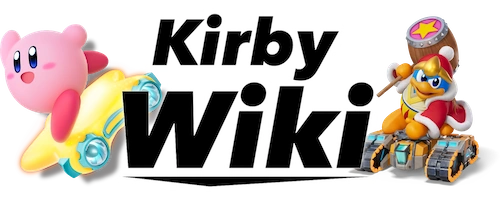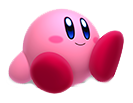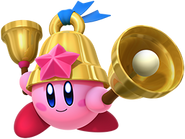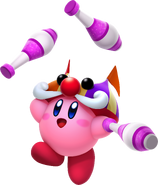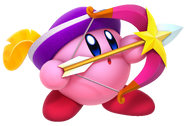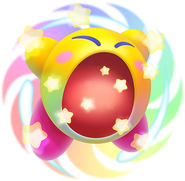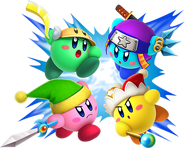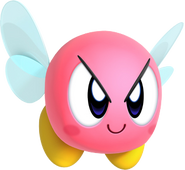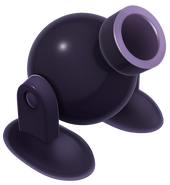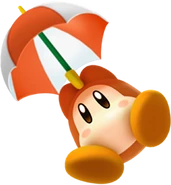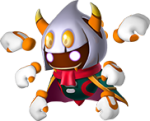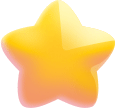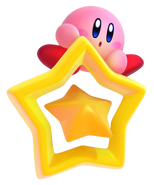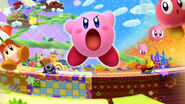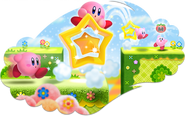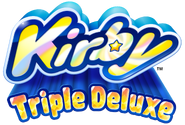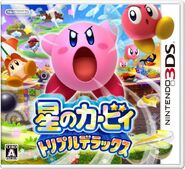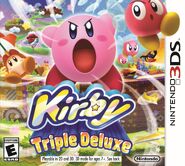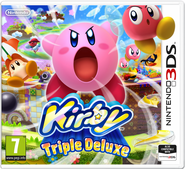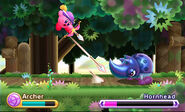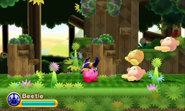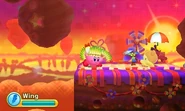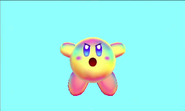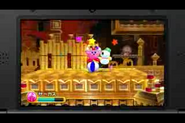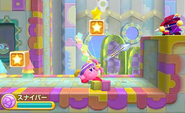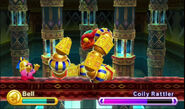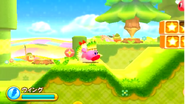Kirby: Triple Deluxe (Hoshi no Kābī: Toripuru Derakkusu, or Kirby of the Stars: Triple Deluxe in Japan) is a Kirby game for the Nintendo 3DS. Kirby: Triple Deluxe was first announced in the October 1, 2013 Nintendo Direct; it was the last thing mentioned. This is the 15th Kirby game and the first for the Nintendo 3DS. It was made available for purchase in retail stores and on Nintendo eShop on January 11th, 2014, in Japan and in North America on May 2, 2014. It was released in Europe on May 16th, 2014 and 17 of May in Australia.
Gameplay
| This section is currently under construction | |
Kirby: Triple Deluxe stays true to classic Kirby games in that the player controls Kirby and the objective is to get to end of the stage by using Copy Abilities. Kirby retains his trademark abilities: the inhale, Star Spit, slide kick, air bullet, and floating. Guarding also returns from the Kirby Super Star games and Kirby's Return to Dream Land, and a new dodge-like move can be performed while guarding. Players can collect stars that have the same function as coins in the Mario series: collecting 100 awards an extra life. Different colors of stars award different star values, a feature returning from Return to Dream Land. Green stars are worth five, red are worth ten, and blue are worth twenty, while yellow stars are worth one. Like most Kirby games, there is a bonus game at the end of every level that can award stars and recovery items. Kirby will lose a life if he runs out of health or falls into a bottomless pit, and running out of lives causes the player to experience a Game Over. Doors and food items, like Invincibility Candy and 1UPs, return. Bandana Waddle Dee occasionally provides Kirby with a random recovery item in a star-shaped bubble, which is stored in the bottom screen and can be used at any time. There is also now an option on the touch screen that allows the player to drop their ability as well.
The game at the end of each level can also award a key chain, which is a collectible in this game. Players can obtain key chains of classic Kirby sprites in levels and look at them from the world map. Sun Stones are also a collectible and a new item in this game. There are two to five of them in each level, and a certain amount need to be collected in order to unlock the boss level in each world, and in turn, complete the world.
The game has mechanics that are used like a 2.5D platformer, and it appears to run on the engine of Kirby's Return to Dream Land. The physics and graphics are mostly reused from the Wii title, although there is a new feature that lets Kirby move into the foreground and the background with an item similar to the Warp Star, similar to a mechanic seen in Donkey Kong Country Returns. This installment takes advantage of the 3DS's 3D technology by frequently having Kirby, projectiles, and other things move toward or away from the screen, an example being seen at the end of a trailer as Kirby gets flattened against the screen. Enemies also can enter Kirby's path from the background and vice versa. Certain new items and abilities allow Kirby to attacks enemies in the background from the foreground and vice versa.
The game also uses gyro controls. When Kirby comes across a certain item, the player can use it by tilting the 3DS. For example, Kirby could be riding a gondola, and the player tilts the 3DS to move the gondola, or if Kirby is in a bowl of water, the player can tilt the 3DS to pour out the water.
Kirby can obtain an new ability, called Hypernova, by touching a Miracle Fruit. It amplifies his signature inhale exponentially, allowing him to inhale things as large as trees; pull large items that are otherwise unmovable; or catch giant projectiles and fire them back.
This game is somewhat of a spiritual sequel to Kirby's Return to Dream Land, and many things return from that game, such as Copy Abilities, like Leaf and Whip, and items, like the Cracker and keys. New mechanics, such as boxes with stars on them that teleport Kirby to other boxes if he steps on them, and glass walls that force Kirby to get rid of his ability when he walks through them, are introduced in this game.
King Dedede is a playable character in this game. Players can choose to use Dedede and play through the story in an Extra Mode called "Dedede Tour!", which is more difficult than the main game, as some enemies are bigger and bosses have "DX" added to the end of their name, implying they are more powerful. Bosses are also colored differently than in the main game. Dedede functions similarly to how he does in Return to Dream Land, with minor changes such as how he can charge his hammer to fire a beam that can cut things like rope and grass. The collectible stars in the main game are replaced by Dedede's symbol: a peace sign that is often mistaken as a rabbit's head, but they function the same way. When playing as Dedede, each of the six levels must be completed in one sitting, and times are recorded after doing so. The initial antagonist of the main game, Taranza, does not appear in the Extra Mode, but Dedede still fights the final boss, Queen Sectonia, at Royal Road. Dedede then fights Shadow Dedede, a new enemy and a dark version of himself, after the latter emerges from the Dimension Mirror, and upon defeating him and entering said mirror, he finds the manifestation of Dark Meta Knight's Revenge. After defeating him, Dark Meta Knight's Revenge is sucked into the Dimension Mirror, and Dedede destroys the mirror, completing the mode. The extra mode is unlocked by completing the main mode.
This game has two sub-games, both of which are new: Kirby Fighters, where the player chooses a Copy Ability and uses it to battle other Kirbys in various arenas, some of which hold references to past Kirby titles, and Dedede's Drum Dash, where the player controls King Dedede as he bounces on drums to the beat of classic Kirby songs and collects coins to earn points. Kirby Fighters is reminiscent of the Super Smash Bros. series, as both that series and the Kirby series were created by Masahiro Sakurai. Kirby Fighters is also multiplayer, and works with Download Play.
The Arena and The True Arena also return from past games, where players choose one ability and use it to defeat as many bosses as they can back-to-back as fast as they can with limited recovery items.
Abilities
Normal Abilities
Kirby can use all of his basic abilities in the game, like his trademark Inhale, slide attack, running, jumping, and floating. Kirby can float for an unlimited amount of time in this game, but he cannot float at all while holding an item, such as the Cracker or a key. Kirby's slide attack still breaks blocks, and by jumping, he can also break blocks from below, similar to Mario in his eponymous series. He retains his air bullet move as well. Kirby can inhale multiple things at once and spit them back out; the more he inhales, the larger and more destructive the Star Spit, another returning move, will be. Kirby's guard returns from Kirby Super Star, which reduces the damage he takes when holding the guard button. A dodge move can also be performed while guarding, similar to the Super Smash Bros. series.
Copy Abilities
A total of 26 Copy Abilities appear in this game. All returning abilities retain their appearance and move sets from Kirby's Return to Dream Land, excluding Wheel, as that ability did not appear in the Wii title.
- Archer
- Beam
- Beetle
- Bell
- Bomb
- Circus
- Crash
- Cutter
- Fighter
- Fire
- Hammer
- Hypernova
- Ice
- Leaf
- Mike
- Needle
- Ninja
- Parasol
- Sleep
- Spark
- Spear
- Stone
- Sword
- Wing
- Wheel
- Whip
King Dedede's Abilities
Dedede controls and functions similarly to how he does in Kirby's Return to Dream Land. In that game, his move set is nearly identical to that of Hammer Kirby in the same game. Dedede can float and guard, just like in Return to Dream Land. Just like Kirby, he can perform a dodge while guarding, a move introduced in Triple Deluxe. Dedede has a few new moves in this game, such as his neutral attack sending out a shock wave in front of him, and his ability to charge his hammer to fire out a beam that cuts things like rope and grass.
Game Modes
Main Mode
After his home is lifted into the sky by a beanstalk called the Dreamstalk, Kirby travels through the six floating islands of a kingdom known as Floralia in pursuit of Taranza, a spider-like foe who has King Dedede captive. After saving Floralia's inhabitants, the People of the Sky, Kirby catches up to Taranza and defeats Dedede after Taranza brainwashes the king. Taranza summons his bee-like master, Queen Sectonia, who dispatches Taranza before attacking Kirby. Kirby defeats the evil queen as well, but she then combines herself with the Dreamstalk and threatens to cover Floralia, Dream Land, and all of Pop Star with vines in order to use the planet as her eternal sustenance. With the help of Dedede, the People of the Sky, and even Taranza, Kirby defeats Sectonia again and saves Floralia.
Dedede Tour! (Extra Mode)
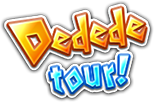
Logo for Dedede Tour.

Title screen of Dedede Tour.
This mode is unlocked by beating the main game once, and stars King Dedede as the main protagonist and playable character. Dedede's move set is similar to Hammer Kirby and the former's move set in Kirby's Return to Dream Land, but Dedede can now shoot a beam by charging his hammer, and create a shock wave with his uncharged hammer attack. This mode is similar to Meta Knightmare Ultra in that each world is compressed into one sitting that must be completed before the player's progress and time can be saved and recorded. Like prior Extra Modes, this mode is more difficult than the main quest, with many changes mirroring those in Kirby's Return to Dream Land's Extra Mode. Enemies vary in size in this Extra Mode and are more numerous than they were before. Bosses and mid-bosses now have 'DX' at the end of their names, and use a number of new attacks, as well as having a new color scheme. All sections requiring Hypernova ability in the main quest are skipped by Dedede, as Dedede cannot access that ability, or any at all. Finally, the stars from the main mode have been replaced by Dedede's trademark peace signs, which serve the same purpose as said stars, and Sun Stones do not appear in this mode.
It is not initially explained why Dedede is travelling Floralia; however, Floralia's inhabitants are once again found to be imprisoned in Royal Road, implying that Dedede is trying to thwart another attempt at global conquest. Taranza does not appear at all in this mode, but Dedede fights Queen Sectonia DX, who initially appears to be the instigator of Floralia's new set of problems, at Royal Road. After she is bested, the Dimension Mirror makes a surprise appearance (strongly implying that Sectonia DX is merely a Mirror World version of the real Sectonia) and releases a dark version of Dedede, known as Shadow Dedede, that promptly attacks the real Dedede. Dedede defeats his counterpart, who shatters into pieces of glass upon defeat, and enters the Dimension Mirror. In a dark alternate dimension-like area, the Dimension Mirror appears again and Dark Meta Knight's Revenge, apparently the villain behind Sectonia DX and Shadow Dedede's actions, emerges to confront Dedede for a final battle. Dedede ultimately vanquishes Dark Meta Knight's Revenge, who is then sucked back into the Mirror. Dedede destroys the Mirror, and the mode is completed.
Kirby Fighters
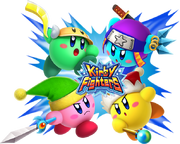
Logo for Kirby Fighters.
In this sub-game, players pick one of ten available Copy Abilities for their Kirby, including the new Archer ability. CPUs are always available as opponents (human players may also be available as opponents). Items are included to aid players/CPUs in battle. There are seven available stages: Flower Land, Castle Lololo, Bubbly Clouds, Coo's Forest, Dedede Arena, Factory Tour, and Another Dimension; an eigth selection, Random may also be available, depending on the mode. Rather than actually being directly fought, characters like Lololo & Lalala, King Dedede, and Kracko are merely hazards of their respective arenas that will occasionally appear. A warning sign usually pops up on the screen before they do so, as is the case of King Dedede when playing on his stage, popping up in the foreground before entering into the actual playing field. His stage is in an arena similar to the one seen in Kirby Super Star and its remake. Bosses can also be KO'd if they take enough damage. All throughout the game, once a player/CPU beats his/her/its opposition, the classic "level complete" tune from Kirby's Dream Land plays. The sub-game itself uses many classic tunes or remixes, as well as the presence of old foes, friends, and stages. Items from previous games return, such as the Mint Leaf and Cracker; new items, like the Timer Dynamite, and 1-time throwable Gordo balls (each enlarged Gordo functioning mainly as a barricade) are also introduced. There are three modes included: Single Player, Multiplayer, and Training.
Single Player
This mode involves CPUs, varying in level/difficulty and number: the player battles 1-3 CPUs, being increasingly-difficult (the level of difficulty chosen before-hand will gradually increase in-game, even with having "Very Hard" as the highest setting) and having different abilities, and progresses through all the stages. This mode has several aspects that make it similar to a fighting game such as Street Fighter. Shadow Kirby is fought on the last Round, and he has the same ability the player chose at the beginning of the tour. When the Single Mode battle is won, a star for rank is placed on the chosen ability's selection tab; the ranking is depicted by different classes of stars won at different difficulties: Bronze for "Easy", Silver for "Normal", Gold for "Hard", and a multi-colored star for "Very Hard" (this star is slightly larger than the others, glows, sparkles, is ribboned, and has gold-trimming; any class ribbon can be obtained right away, since difficulty level is not pre-ordered/unlockable, although the choosable difficulty is ordered from descending to ascending.
Multiplayer
This mode allows up to four people to play together via the 3DS's Download and Play application. Players without a copy of the game are limited to the use of Sword and Cutter only. During multiplayer, each participant chooses a map, and then one of those maps is randomly selected to play on.
Training
The core focus of this sub-game is apparently to find out "which Copy Ability is the best" (or most suited to a player's skills); it's also all about honing one's skills with the 10 abilities (particularly to master Single Player mode's 10 abilities by beating the four levels of difficulty attached to each ability). In Training mode, players can customize what color their Kirby is, as well as the CPUs' (Computer Player Unit): the three CPUs' default colors are the blue, green, and yellow coloring. Player 1 can edit several settings in an Options menu that can be accessed before a battle by pressing "Y" on the Player Settings screen; these include: item rate, handicaps, Ghost Kirby availability, and hazards. The player can then either play alone w/ 1-3 CPUs, or with up to three other players.
Dedede's Drum Dash

Logo for Dedede's Drum Dash.
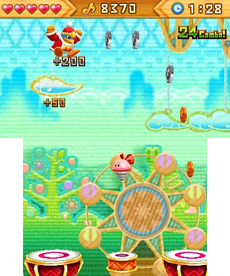
The first stage of DeDeDe's Drum Dash.
Players take the role of King Dedede, who bounces on drums and collects coins. Players press the A button to increase the height of their jump on a drum, and keep the backbeat of the song going at the height of their jump. Collecting coins and keeping the beat awards more points. A significantly larger drum is the last one in the stage and upon bouncing on it correctly, it launches Dedede up off the screen, clearing the stage. There is also a medal system - the more points the player earns, the higher the medal rank is; bronze, silver, gold, or platinum, the latter of which is the highest rank. There are also four extra medals that award bonus points for taking no damage, getting all of the coins, beating the level under a certain time, and one for hitting every backbeat at the height of each jump, respectively. There are four songs of increasing difficulty, one being unlockable after mastering the previous three. Players can keep the beat to these classic and/or modern Kirby tunes:
- Stage 1 - Green Greens theme
- Stage 2 - Gourmet Go Go (Gourmet Race theme (courses 1 and 3))
- Stage 3 - King Dedede 's theme
- Extra (Stage 4) - Distant Traveler (Magolor Race EX)
The Arena

Logo for The Arena.
Players choose one Copy Ability and battle the all of the game's bosses consecutively as fast as they can without dying. In this game's Arena, players are given five Maxim Tomatoes and a choice of two random Copy Abilities between battles, similar to Kirby's Return to Dream Land's Arena. One of the Maxim Tomatoes is in a bubble, like the recovery items in bubbles Bandana Waddle Dee occasionally gives to Kirby in the main game; this allows the player to take the Maxim Tomato into battle and use it whenever they like, similar to how they could carry a box with a Maxim Tomato in it into battle in Kirby's Return to Dream Land's Arena. After a Maxim Tomato is used, a regular tomato appears in its place the next time the player enters the rest room, which does not respawn after being consumed. Treasure chests containing key chains occasionally appear upon returning to the rest room.
In order to move on to the next boss, players must touch the 3D Warpstar that is in the rest room in order to move from the foreground, where the two random ability pedestals are, to the background, where the five Maxim Tomatoes and the door to progress is. Players fight every boss and mid-boss in a random order, with the exception of King Dedede and Queen Sectonia, who are always fought second-to-last and last respectively, only returning to the rest room after the boss has been defeated. Like prior Arenas, the mid-bosses are fought in groups before returning to the rest room; Grand Wheelie, Bonkers, and Hornhead are fought in one set, while Mr. Frosty, Flame Galboros, Gigant Edge, and Blocky are fought in the other. Masked Dedede and his second form must also be defeated in one sitting before returning to the rest room. Queen Sectonia's third form is not fought, but her first and second forms are; unlike Dedede, the two forms are not fought in one sitting, allowing Kirby to heal up before the final battle.
The True Arena
The True Arena also returns in this game, pitting Kirby against the DX bosses that King Dedede fights in Dedede Tour. This mode is unlocked by beating Extra Mode once. Only four normal tomatoes and a single Maxim Tomato in an Assist Star are available in the rest room.
Like The Arena, most of the bosses are fought in a random order, but like previous True Arena sub-games, the last few bosses (four in this case) are fought in a specific order. Queen Sectonia DX is fought first, followed by Shadow Dedede, Dark Meta Knight's Revenge, and - for the first time in the game - Soul of Sectonia, a form which resulted from Sectonia eating four Miracle Fruits after her defeat in the main mode. After this form of Sectonia is defeated, she rips her body and wings out of the wilting Dreamstalk and engages Kirby in a surprise final battle. When she is defeated for the sixth and final time in the game, Sectonia explodes into a shower of blue petals, finishing the True Arena and ending her threat for good. 2
Levels
- Fine Fields
- Lollipop Land
- Old Odyssey
- Wild World
- Endless Explosions
- Royal Road
- Eternal Dreamland
Items
- 1UP
- 3D Laser Bar
- Action Star
- Assist Star
- Cracker
- Cracker Cap*
- Food
- Invincibility Candy
- Key
- Keychain
- Maxim Tomato
- Mike
- Mint Leaf
- Miracle Fruit
- Pep Brew
- Reviving Tomato
- Star
- Sun Stone
- Timed Dynamite
- Treasure Chest
Story
| Spoiler alert: The following section contains plot-specific details.(Skip Section) |
|---|
After a day of fishing, flying, and relaxing, a massive beanstalk called the Dreamstalk lifts Kirby's house high above the ground one night while he is sleeping. When he wakes up the next day, Kirby realizes his house isn't on the ground anymore, instead being in the air in the mysterious kingdom known as Floralia. He runs out of his house and falls onto a part of the beanstalk, and spots King Dedede's castle above him, which was also lifted by the beanstalk. He climbs the beanstalk to reach the castle, and spots a spider-like creature named Taranza entering the castle. Kirby curiously follows Taranza and watches as it easily dispatches many of Dedede's Waddle Dee guards and proceeds to capture Dedede, surrounding him in a strange purple aura. Taranza breaks through Dedede's glass ceiling and ascends the Dreamstalk with him in tow, with Kirby following close behind.
One way or another, Taranza prompts all of Kirby's boss battles. Prior to Royal Road, when Kirby catches up to Taranza, he either aggravates an enemy, or animates it with spider web-esque magic so as to stall him. Using his magic, he turned a flower into Flowery Woods, turned a cloud into Kracko, and brought a stone Coily Rattler to life. On the other hand, he moved Paintra's drawing and threw a rock at Pyribbit, prompting them both to attack Kirby. In Royal Road, Kirby enters several of what seem to be alternate dimensions and rescues The People of the Sky who are imprisoned there, who then help him find Taranza's hideout. Upon entering said hideout - a structure reminiscent of a castle - Kirby finds Taranza, who, rather than running, notes Kirby on his persistence. He vaguely states that he saw right through the People of the Sky's plan and assumes Kirby followed him in order to save "the hero of the lower world". Taranza then says he'll give Kirby his hero back (albeit "a bit more hostile"), and takes complete control of Dedede, turning him into his Masked form, and forcing him to fight Kirby. Kirby defeats Dedede, breaking his hammer and part of his mask in the process, but Taranza enhances his powers still further, causing Dedede's robes to turn purple. Dedede grabs an axe and confronts Kirby once more. In spite of this, Dedede is defeated again and what remains of his mask is destroyed, and Taranza's control over the king dissipates.
Taranza approaches and unconscious Dedede, confused as to how Kirby defeated them, as he did just as his master ordered. He considers Kirby to be the true hero of Dream Land, and summons his master, Queen Sectonia, to save him from suffering the same fate as Dedede. Sectonia, displeased by Taranza's failure to follow her orders (she ordered him to kidnap Dream Land's hero, Kirby, and instead he kidnapped Dedede, who he mistook as Dream Land's hero), immediately blasts him out of the castle and into the sky, before attacking Kirby. Kirby defeats the evil queen, and begins to celebrates with a now-awake Dedede. However, Queen Sectonia rises again and combines herself with the Dreamstalk. Under her control, the Dreamstalk's vines begin to grow explosively, covering Floralia, Dream Land, and even Pop Star itself. As Kirby and Dedede panic, the People of the Sky that Kirby previously saved appear with a cannon-like device that Kirby and Dedede then use to combat the vines. Dedede repeatedly shoots Kirby at flowers on the vines, weakening them and creating an opening to Queen Sectonia that Dedede fires Kirby into.
Kirby ascends the Dreamstalk, and battles and defeats Sectonia a second time. Kirby again begins to celebrate, but a vine grabs Kirby by the foot and captures him as Sectonia rises for a third time. Just then, Taranza appears with Dedede in tow, ready to help. Taranza throws Dedede at Kirby, and Dedede smacks Kirby free with his hammer. Dedede throws a KO'd Kirby at Taranza, who throws a Miracle Fruit at Kirby, giving Kirby his Hypernova ability and filling him with life. Kirby confronts Sectonia once more, who uses the buds on her vines to fire missiles at Kirby and shield herself. Kirby inhales the buds and shoots them at each other until all four are destroyed, disallowing Sectonia to create a shield. Sectonia makes a last ditch attempt to defeat Kirby by firing an enormous beam at him, only for Kirby to inhale the beam and send it back at her, destroying her for the third and seemingly final time.[1].
Sectonia's vines rapidly disintegrate, freeing Pop Star and causing Kirby and Dedede to fall from the sky. The People of the Sky catch Kirby and his home and Taranza catches Dedede. It is explained that although the Dreamstalk did not directly bring Kirby to Floralia's rescue, Kirby ended up saving the People of the Sky regardless, thanks to Taranza kidnapping Dedede and Kirby attempting to save the king, as well as Taranza and Dedede's help in Eternal Dreamland: the Dreamstalk works in mysterious ways.
| End of spoilers |
|---|
Announcement History
| This section is currently under construction | |
- On October 1, 2013, the game was first unveiled by Satoru Iwata as the last thing in that day's Nintendo Direct. The game's first trailer was also shown.
- On November 14, 2013, the title for the game in North America was revealed to be Kirby: Triple Deluxe.
- On November 15, 2013, a teaser site was revealed in Japan and the release dates were announced: January 11, 2014 in Japan, and a TBA 2014 release window for North America and Europe.
- On December 18, 2013, Nintendo revealed two new Copy Abilities, Circus and Archer, and the new modes, Kirby Fighters and Dedede's Drum Dash, via Nintendo Direct.
- The game saw its Japanese release on the originally scheduled date: January 11, 2014.
- The Febuary 13, 2014 Nintendo Direct scheduled it to release on May 2 in North America and May 16 in Europe.
- The game saw it's North American release on the originally scheduled date: May 2, 2014.
- The game saw it's European release on the originally scheduled date: May 16, 2014.
Characters
Major Characters
Main Game
- Kirby
- King Dedede
- Taranza
- Queen Sectonia
- The People of the Sky
- Bandana Waddle Dee
- Shadow Dedede (Dedede Tour!)
- Dark Meta Knight's Revenge (Dedede Tour!)
Sub-games
- Rick
- Coo
- Kine
- Shadow Kirby (possibly different than the one found in Kirby & The Amazing Mirror)
Playable Characters
Enemies
| This section contains content derived from Japanese | |
In the last level, Royal Road, many common enemies are replaced by different looking enemies that function the same, similar to the last two levels in Kirby's Return to Dream Land. These enemies all have the word "sectra" or "sectle" before their name.
Normal Enemies
| This article contains content derived from Japanese | (Edit | (Similar) |
| ...because it was never localized to English in official sources. | |
- Antr
- Barbar
- Big Waddle Dee
- Birdon
- Beetley
- Blade Knight
- Blipper
- Bomber
- Bouncy
- Bronto Burt
- Broom Hatter
- Cappy
- Carry Dee
- Chilly
- Chip
- Como
- Craby
- Degout
- Dekabu
- Dingle
- Funny Robatics
- Flame Garaga
- Flamer
- Foley
- Fuwa Rover
- Ghost Gordo
- Giant Gordo
- Glunk
- Gordo
- Grizzo
- Horror Tramp
- Hot Head
- Hunter Scarfy
- Kabu
- Knuckle Joe
- Lanzer
- Leafan
- Lord Antr
- Mamanti
- Mumbies
- Noddy
- Pacto
- Parasol (enemy)
- Parasol Sectle Dee
- Parasol Waddle Dee
- Pierce
- Poppy Bros. Jr.
- Rocky
- Scarfy
- Sectle Dee
- Sectra Burt
- Sectra Gordo
- Sectra Knight
- Sectra Shooter
- Search
- Sheld
- Shotzo
- Sir Kibble
- Soarar
- Sparky
- Sodory
- Squishy
- Spinum
- Tick
- Toughness Waddle Dee (in Copy trial room)
- Tsukikage
- Waddle Dee
- Waddle Doo
- Walky
- Wheelie Bike
- Whippy
- UFO (Goal Game)
Enemies defeated with the Hypernova ability
| This article contains content derived from Japanese | (Edit | (Similar) |
| ...because it was never localized to English in official sources. | |
- Ace Fuwa Rover
- Big Missile
- Cannon Tower
- Egger Wings
- Gigant Cox
- King Fuwa Rover
- Land Barbar
- Maurice Brothers
- Pipe Worm
- Waddle Dees' Steel Fortress
Mid-bosses
Bosses
- Flowery Woods (Fine Field)
- Paintra (Lollipop Land)
- Kracko (Old Odyssey)
- Coily Rattler (Wild World)
- Pyribbit (Endless Explosions)
- Masked Dedede and Masked Dedede's Revenge (Royal Road)
- Queen Sectonia (Royal Road and Eternal Dreamland, final boss)
- Shadow Dedede (Dedede Tour!'s Royal Road)
- Dark Meta Knight's Revenge (Dedede Tour!'s final boss)
- Soul of Sectonia (The True Arena's final boss)
- Shadow Kirby (Kirby Fighters)
Trivia
- The Japanese box art for Kirby: Triple Deluxe depicts Kirby inhaling. This makes it the second game in the series to show Kirby's suction ability on the cover -- the first is the international box art for Kirby's Adventure.
- This is also the first Kirby game to feature an angry-looking Kirby on the Japanese box art, as the expression is mostly used on North American box arts.
- The title references the 3D focus of this game; 'Triple' is derived from the number 3, and the 'Deluxe' can be shortened to its first letter, D. When put together, the title literally becomes "Kirby 3D".
- During the new Hypernova ability's transformation, the pink and red colors of Kirby's body burst off of him.
- The background music in the first part of the trailer depicting the features of the Nintendo 3DS Gyroscope is possibly a remix of the unused theme from Kirby's Dream Land 2.
- The first letters of all the levels in order, spell FLOWERED, a reference to Queen Sectonia's final form.
- This is the fifth instance in the Kirby series where the first letters of the stages create an acronym; the other four are in Kirby's Adventure, Kirby: Canvas Curse, Kirby's Return to Dream Land, and Kirby's Dream Collection: Special Edition.
- This is the second game where the acronym is a direct reference to a major villain that is only seen at the end of the game, the first being Kirby's Return to Dream Land.
- The name of the music for the final battle of the main game is FLOWERED. This is the second game where the final battle's song's name is the acronym that the levels' first letter make. The first is Kirby's Return to Dream Land.
- The People of the Sky slightly resemble the fairies from Kirby 64: The Crystal Shards.
- Pyribbit, the boss of Endless Explosions, looks and attacks a lot like Fatty Puffer.
- He can also summon pillars of lava that resemble Magman.
- This is the first game to use gyro controls since Kirby Tilt 'n' Tumble.
- Subtle changes were made between the Japanese and North American box arts. The most notable of these changes (besides the title and ESRB ratings) was the removal of Shotzo from the cover. This may have been done for censorship reasons, as the Shotzo on the Japanese cover is depicted shooting at the viewer. The European box art is left unchanged, however.
- The built-in 3DS game StreetPass Mii Plaza's Puzzle Swap contains a puzzle panel for Kirby: Triple Deluxe.
- This is the third Kirby game to feature the bosses spawning blood, the first being Kirby's Dream Land 3 and the second being Kirby 64: The Crystal Shards
Trailers
| Trailer |
|---|
